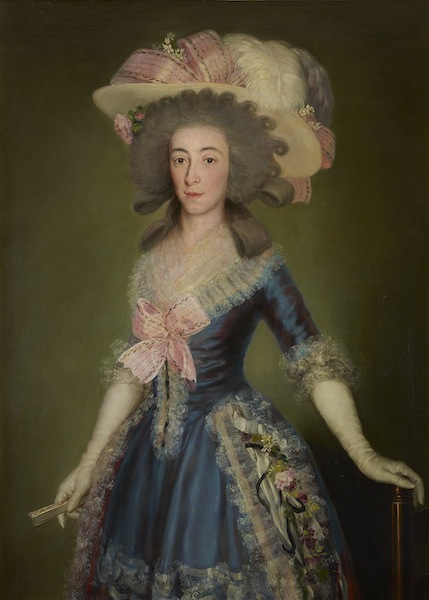The brute nature of man in times of war, religious persecution and hypocrisy, and the destructive power of superstition. Francisco de Goya’s fame today largely rests on such themes, and they go a long way to explain just why he’s often considered the first modern artist.
But Goya was also a remarkable portraitist, an official painter to the Spanish court, and one of art's great sensualists. And though we don’t have the famous nude and clothed Maja, which hang side-by-side in the Prado, the National Gallery’s thrillingly seductive exhibition attests to his renown as a master of the portrait – though not one who was without faults.
What, for instance, is happening with the alarmingly truncated legs of Francisco de Saavedra, the soberly handsome finance minister who sits contemplatively at his desk? Painted in 1798, recent technical examination shows that the finely painted head came first, with the rest of the body painted later at speed. Those lower limbs, affixed to that overlong torso, certainly seem to have come as an afterthought.
Goya’s legs and arms do occasionally go awry, and his sitters sometimes resemble little more than enchanting dolls. The Duke and Duchess of Osuna and their Children, 1788, is a clear case in point. With its finely dressed figures as stiff as painted wooden puppets, this otherwise affectionate family portrait hardly attests to his great skills of psychological penetration.
But when Goya is good he is often great, and these qualms only highlight that genius – an unfashionable word and an old-fashioned concept, for sure – though instinctive, still has to be worked at; since there is no formula, to rise to the challenge of its demands is risky. And technical perfection, although there is plenty of that here – just look at the exquisite dress, with its laces, bows, floral embellishments, of the gimlet-eyed Countess-Duchess of Benavente (pictured below; 1785; Private Collection © Joaquín Cortés) – can’t lend a work of art energy. This exhibition is so full of energy that it bristles and crackles with life.
 This leads us to the thing that makes so many of these portraits appear so very modern. Often they’re like snapshots. Faces betray hilarity, surprise, intrigue, each suggesting a fleeting moment. Often the subject appears as if caught unawares; sometimes as if they are about to speak. Words appear to be forming in the mouth of the bewigged Juan de Villanuevea; a passing cloud of consternation troubles the pale complexion of Juan Antonio Meléndex Valdés; and one hearty gentleman in the dynamic group portrait The Family of the Infante Don Luis de Bourbon, 1783-4, positively beams with amusement at the viewer, his arresting gaze lusty and penetrating. How often do we get to see wide grins in a formal portrait? Well, Goya achieves them with all the virtuosic naturalness that makes the scene convincing and animated. There are no ghastly rictus grimace-grins here.
This leads us to the thing that makes so many of these portraits appear so very modern. Often they’re like snapshots. Faces betray hilarity, surprise, intrigue, each suggesting a fleeting moment. Often the subject appears as if caught unawares; sometimes as if they are about to speak. Words appear to be forming in the mouth of the bewigged Juan de Villanuevea; a passing cloud of consternation troubles the pale complexion of Juan Antonio Meléndex Valdés; and one hearty gentleman in the dynamic group portrait The Family of the Infante Don Luis de Bourbon, 1783-4, positively beams with amusement at the viewer, his arresting gaze lusty and penetrating. How often do we get to see wide grins in a formal portrait? Well, Goya achieves them with all the virtuosic naturalness that makes the scene convincing and animated. There are no ghastly rictus grimace-grins here.
And then there are the self-portraits, ranging from the youthfully pudgy-faced to old age and, literally, near death. The rarely loaned Self-Portrait with Doctor Arrieta, 1820 (main picture), from the Minneapolis Institute of Art, shows the artist barely conscious, in the grip of an unknown malady (a serious illness, whose cause was also unknown, had left him profoundly deaf almost 30 years earlier). He clutches at his bedspread as the doctor attempts to administer some potion or reviving beverage. Faces – priests or demons, perhaps figments conjured by Goya’s delirium – haunt the shadows. Dr Arrieta is Goya’s friend and saviour and the painting is gifted to him – a dedication appears at the bottom of the canvas – yet he, too, looks sinister.
There is so much life, drama and emotion here, among the 70-odd portraits in this tremendous exhibition. This is what makes Goya great, and it’s also what makes him feel so much our contemporary.









![SEX MONEY RACE RELIGION [2016] by Gilbert and George. Installation shot of Gilbert & George 21ST CENTURY PICTURES Hayward Gallery](/sites/default/files/styles/thumbnail_125_x_125_/public/mastimages/Gilbert%20%26%20George_%2021ST%20CENTURY%20PICTURES.%20SEX%20MONEY%20RACE%20RELIGION%20%5B2016%5D.%20Photo_%20Mark%20Blower.%20Courtesy%20of%20the%20Gilbert%20%26%20George%20and%20the%20Hayward%20Gallery._0.jpg?itok=3oW-Y84i)





Add comment